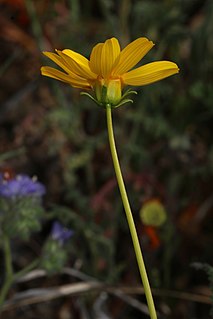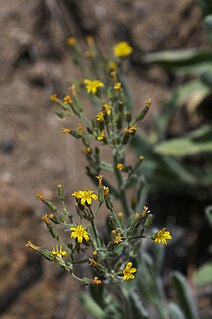
Iva is a genus of wind-pollinated plants in the daisy family, described as a genus by Linnaeus in 1753. Plants of this genus are known generally as marsh elders. The genus is native to North America.

Coreopsis bigelovii is a species of flowering plant in the daisy or sunflower family, Asteraceae, with the common names Bigelow coreopsis and Bigelow's tickseed. It is endemic to California.

Coreopsis maritima, the sea dahlia, is a species of tickseed in the sunflower family.

Baccharis halimifolia is a North American species of shrubs in the daisy family. It is native to Nova Scotia, the eastern and southern United States, eastern Mexico, the Bahamas, and Cuba.

Pilosella horrida, known as the prickly hawkweed or shaggy hawkweed, gets its name from the long, dense, shaggy white to brown hairs (trichomes) which cover all of the plant parts of this plant species. The species is native to Oregon, California, and Nevada in the western United States.
Erigeron breweri is a North American species of flowering plants in the daisy family known by the common name Brewer's fleabane.

Geraea viscida is a species of flowering plant in the daisy family known by the common name sticky geraea, or sticky desertsunflower. It is native to southern California, mainly the chaparral hills of eastern San Diego County, and nearby Baja California.

Helianthus gracilentus is a species of sunflower known by the common name slender sunflower. It is native to central and southern California and Baja California, where it is a member of the dry wildfire-prone chaparral ecosystem.
Hulsea californica is a rare species of flowering plant in the daisy family known by the common names San Diego alpinegold and San Diego sunflower. It is endemic to southern California, where it grows only in the Peninsular Ranges.

Xylococcus is a monotypic genus of flowering plants in the heath family which contains the single species Xylococcus bicolor, the mission manzanita.

Chaenactis glabriuscula, with the common name Yellow pincushion, is a species of flowering plant in the daisy family. It is native to California and Baja California.
Chaenactis parishii is a species of flowering plant in the daisy family known by the common name Parish's chaenactis.

Quercus cornelius-mulleri is a North American species of oak known by the common name Muller oak, or Muller's oak. It was described to science in 1981 when it was segregated from the Quercus dumosa complex and found to warrant species status of its own. It was named after the ecologist Cornelius Herman Muller. It is native to southern California and Baja California, where it grows in chaparral, oak woodlands, and other habitat in foothills and mountains. It can most easily be observed in Joshua Tree National Park and in the woodlands along the western margins of the Colorado Desert in San Diego County, California.
Ribes canthariforme is a rare North American species of currant known by the common name Moreno currant.

Iva frutescens is a species of flowering plant in the aster family known by the common names Jesuit's bark, bigleaf marsh-elder, and high-tide bush. It grows in coastal eastern North America from Nova Scotia down the eastern coast and along the Gulf Coast to Texas.

Cyclachaena xanthiifolia, known as giant sumpweed, or rag sumpweed is a North American plant species in the sunflower family, Asteraceae. It is the only species in the genus Cyclachaena. Giant sumpweed is believed to be native to the Great Plains but is now found across much of southern Canada and the contiguous United States, though rarely in the Southeast.

Iva imbricata is a North American species of flowering plant in the aster family known by the common names dune marsh-elder and seacoast marsh elder. It is native to Cuba, the Bahamas, and coastal areas of the United States from Texas to Virginia. It is a low shrub, found on sand dunes and the upper beach. It is a highly salt tolerant plant, and is often the perennial plant closest to the ocean.
Iva angustifolia is a species of flowering plant in the daisy family known by the common name narrowleaf marsh elder. It grows in the south-central and southeastern United States.

Iva axillaris, called povertyweed or death weed, is a North American species of flowering plants in the daisy family. It grows in the western and central United States and in western Canada, from British Columbia south to California and east as far as the western Great Plains in the Texas Panhandle, Nebraska, the Dakotas, and Manitoba. It has also become established in Australia, where it is considered a weed.
Iva microcephala, the piedmont marsh elder, is a North American species of flowering plants in the daisy family. It grows in the southeastern United States in Alabama, Florida, Georgia, and the Carolinas.















